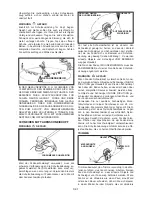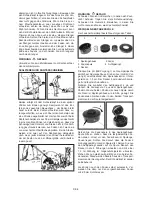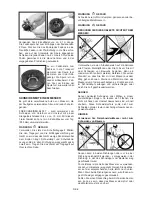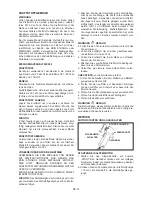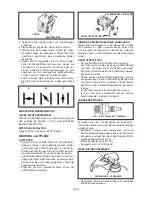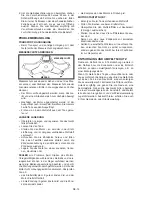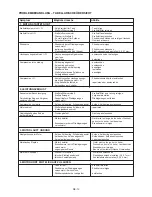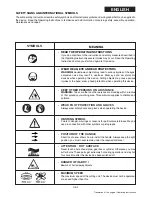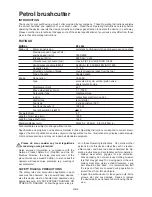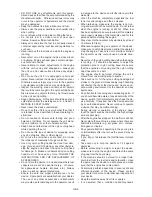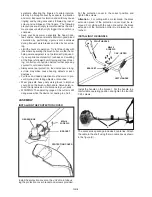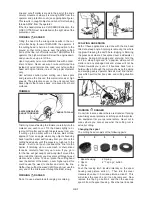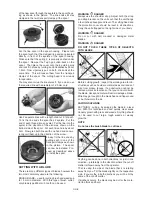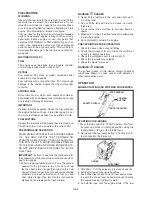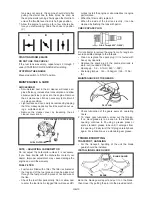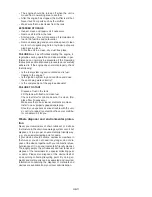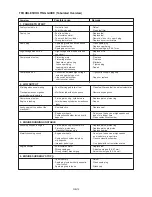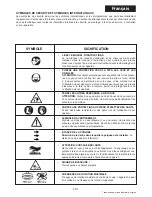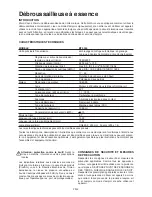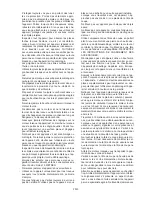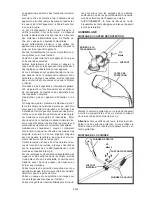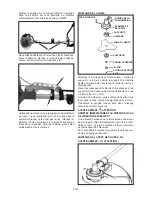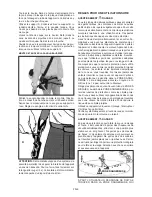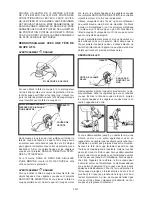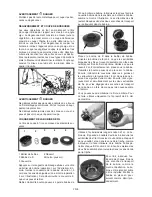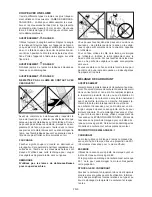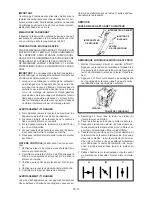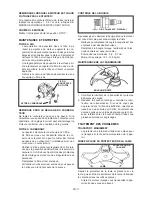
WARNING
DANGER
Always use the shoulder strap. Adjust both the strap
and strap bracket on the unit such that the unit hangs
a few inches above ground level. The cutting head and
the protection cover should be level in all directions.
Carry the unit strapped on the right side of your body.
WARNING
DANGER
Do not cut with dull, cracked or damaged metal
blades.
WARNING
DANGER
DO NOT TOUCH THESE TYPES OF OBJECTS
WITH BLADE
Before cutting growth, inspect the working area for ob-
structions such as boulders, metal stakes or strands of
wire from broken fences. If an obstruction cannot be
removed, mark its location so that you can avoid it with
the blade. Rocks and metal will dull or damage a blade.
Wire may get caught in the blade head and flap around
or be thrown into the air.
SAWING SAPLINGS
SCYTHING - cutting by swinging the blade in a level
arc. With this technique one can quickly clear areas
densely grown with grass and weeds. Scything should
not be used to cut large, tough weeds or woody
growths.
NOTE
Do not use the brush blade to cut trees.
Scything can be done in both directions, or just in one
direction – preferably in the direction where the cut-off
matter is thrown away from the operator.
That is using the side of the blade that it is rotating
away from you. Tilt the blade slightly on the respective
side. If you scythe in both directions you will be hit by
some of the cut-off matter.
If kickback occurs, the blade may be dull or the mate-
rial too thick and hard.
of the new spool through the eyelets in the spool hous-
ing as shown in the picture. The line ends still stay
clamped in the two transport clamps pf the spool.
1
2
Put the line spool in the spool housing. Please turn
the spool such that the clamped line ends are located
directly in front of the eyelets of the spool housing.
Make sure that the spring 2 is properly seated under
the spool. Now put the Tap’n go button back on the
spool. Then place the cover onto the 4 guiding pins
and lock it in place by turning it anti-clockwise by about
1.5cm. Now vigorously pull on both line ends at the
same time. This will loosen them from the transport
clamps of the spool. The cutting head is now ready
for operation.
You may also coil up the line yourself. If you do so, use
the required line with a diameter of 2.5 mm only.
Use 2 separate lines with a length of about 2.1m each.
To fix the line ends the spool has 2 eyelets. Put the
end of each thread into an eyelet. Put the line into the
eyelet in the direction of the arrow as shown on the
bottom side of the spool. Put each line end in by about
2cm. Now grab both lines with one hand and concur-
rently coil them up in the direction of the arrow.
Finally, fix the line ends by
putting each in one of the
transport clamps as shown
in the picture. The spool
can now be installed. Pro-
ceed as described above
to install the spool.
CUTTING WITH A BLADE
There are many different types of blades, however the
two most commonly used are the following.
BRUSH BLADE – used for cutting brush and weeds up
to 15 mm in diameter. With this type of brush cutter,
only blade type 255mm / 3-tooth can be used.
GB-
8
Summary of Contents for BT 4344
Page 2: ......
Page 94: ...GR 1 15 ELLHNIKA...
Page 96: ...15 15 GR 3...
Page 97: ...Raynaud GR 4...
Page 98: ...M5xl6 M5x20 M5x25 X 2 X 2 1 1 2 2 2x16 3 A B GR 5...
Page 99: ...A 3 B A S 4 mm 2x16 A B x x GR 6...
Page 100: ...15 16 15 METERS 50 FEET 15 GR 7...
Page 101: ...Monofil 2 5 mm KNIFE SIDE RAISED ANGLE TO GROUND ANGLE TO WALL 2 3 4 5 1 1 2 3 4 5 GR 8...
Page 102: ...1 2 1 5 cm 5 4 3 1 2 2 4 1 5 cm 2 5 mm 2 2 1 m 2 2 cm 15mm 3 255 mm GR 9...
Page 103: ...89 30 1 2 2 30 1 89 30 1 2 30 1 1 2 3 4 3 4 GR 10...
Page 104: ...5 6 1 2 3 4 5 STOPP l Stopp START 2 7 10 CHOKE 3 A 4 5 B 6 7 C A B C 3 7 Stopp STOP GR 11...
Page 105: ...O 6 0 7mm 0 023 O 028 0 6 0 7 mm 145 155 kg cm 1 25 2 GR 12...
Page 106: ...2 GR 13...
Page 107: ...1 0 6 0 7 mm Stop 2 3 0 6 0 7 mm 0 3 0 4 mm 4 GR 14...
Page 108: ......
Page 114: ......
Page 119: ......

